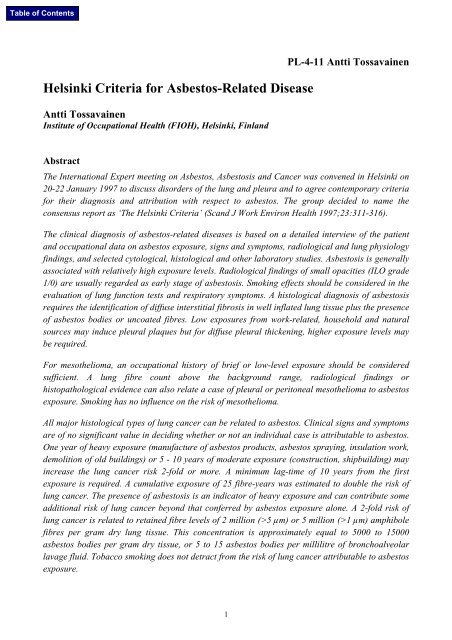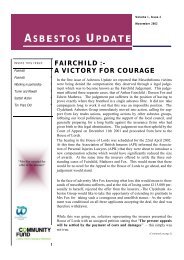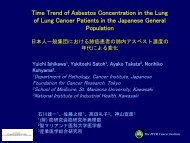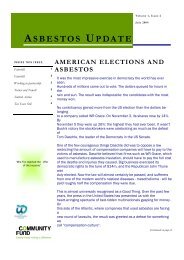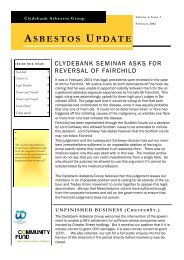Helsinki Criteria for Asbestos-Related Disease - Clydebank ...
Helsinki Criteria for Asbestos-Related Disease - Clydebank ...
Helsinki Criteria for Asbestos-Related Disease - Clydebank ...
You also want an ePaper? Increase the reach of your titles
YUMPU automatically turns print PDFs into web optimized ePapers that Google loves.
Table of Contents<br />
<strong>Helsinki</strong> <strong>Criteria</strong> <strong>for</strong> <strong>Asbestos</strong>-<strong>Related</strong> <strong>Disease</strong><br />
Antti Tossavainen<br />
Institute of Occupational Health (FIOH), <strong>Helsinki</strong>, Finland<br />
PL-4-11 Antti Tossavainen<br />
Abstract<br />
The International Expert meeting on <strong>Asbestos</strong>, <strong>Asbestos</strong>is and Cancer was convened in <strong>Helsinki</strong> on<br />
20-22 January 1997 to discuss disorders of the lung and pleura and to agree contemporary criteria<br />
<strong>for</strong> their diagnosis and attribution with respect to asbestos. The group decided to name the<br />
consensus report as ‘The <strong>Helsinki</strong> <strong>Criteria</strong>’ (Scand J Work Environ Health 1997;23:311-316).<br />
The clinical diagnosis of asbestos-related diseases is based on a detailed interview of the patient<br />
and occupational data on asbestos exposure, signs and symptoms, radiological and lung physiology<br />
findings, and selected cytological, histological and other laboratory studies. <strong>Asbestos</strong>is is generally<br />
associated with relatively high exposure levels. Radiological findings of small opacities (ILO grade<br />
1/0) are usually regarded as early stage of asbestosis. Smoking effects should be considered in the<br />
evaluation of lung function tests and respiratory symptoms. A histological diagnosis of asbestosis<br />
requires the identification of diffuse interstitial fibrosis in well inflated lung tissue plus the presence<br />
of asbestos bodies or uncoated fibres. Low exposures from work-related, household and natural<br />
sources may induce pleural plaques but <strong>for</strong> diffuse pleural thickening, higher exposure levels may<br />
be required.<br />
For mesothelioma, an occupational history of brief or low-level exposure should be considered<br />
sufficient. A lung fibre count above the background range, radiological findings or<br />
histopathological evidence can also relate a case of pleural or peritoneal mesothelioma to asbestos<br />
exposure. Smoking has no influence on the risk of mesothelioma.<br />
All major histological types of lung cancer can be related to asbestos. Clinical signs and symptoms<br />
are of no significant value in deciding whether or not an individual case is attributable to asbestos.<br />
One year of heavy exposure (manufacture of asbestos products, asbestos spraying, insulation work,<br />
demolition of old buildings) or 5 - 10 years of moderate exposure (construction, shipbuilding) may<br />
increase the lung cancer risk 2-fold or more. A minimum lag-time of 10 years from the first<br />
exposure is required. A cumulative exposure of 25 fibre-years was estimated to double the risk of<br />
lung cancer. The presence of asbestosis is an indicator of heavy exposure and can contribute some<br />
additional risk of lung cancer beyond that conferred by asbestos exposure alone. A 2-fold risk of<br />
lung cancer is related to retained fibre levels of 2 million (>5 µm) or 5 million (>1 µm) amphibole<br />
fibres per gram dry lung tissue. This concentration is approximately equal to 5000 to 15000<br />
asbestos bodies per gram dry tissue, or 5 to 15 asbestos bodies per millilitre of bronchoalveolar<br />
lavage fluid. Tobacco smoking does not detract from the risk of lung cancer attributable to asbestos<br />
exposure.<br />
1
Background<br />
Despite national and international actions, occupational exposure to asbestos continues to be a<br />
major health hazard. Up to 20 000 asbestos-induced lung cancers and 10 000 mesotheliomas occur<br />
annually in Western Europe, Scandinavia, North America, Japan and Australia. In the most affected<br />
age groups, mesothelioma may account <strong>for</strong> about 1 % of all deaths. In addition, about 5-7 % of all<br />
lung cancers can be attributed to asbestos exposure. The life cycle of asbestos products begins in the<br />
primary asbestos industry and continues with secondary manufacture, installation, usage and<br />
disposal. Worldwide millions of workers have been exposed to asbestos in the workplace, most<br />
often during use, maintenance, repair and replacement of asbestos-containing materials. About 170<br />
tons of produced and consumed asbestos will cause at least one death from pleural or peritoneal<br />
mesothelioma and contribute to several cases of lung cancer, asbestosis and pleural abnormalities<br />
[1]. Thousands of asbestos-related diseases will be diagnosed and treated by clinicians across<br />
industrialized countries in the next 20 to 30 years and even later in the developing world.<br />
The International Expert Meeting on <strong>Asbestos</strong>, <strong>Asbestos</strong>is and Cancer was convened in <strong>Helsinki</strong> on<br />
20-22 January 1997 to discuss disorders of the lung and pleura and to agree upon contemporary<br />
criteria <strong>for</strong> the diagnosis and attribution with respect to asbestos. The group decided to name the<br />
consensus report as 'The <strong>Helsinki</strong> <strong>Criteria</strong>' [2,3]. Accordingly, the clinical diagnosis of asbestosrelated<br />
diseases should be based on a detailed interview of the patient and occupational data on<br />
asbestos exposure, signs and symptoms, radiological and lung physiology findings and selected<br />
cytological, histological and other laboratory studies. Subsequently the <strong>Helsinki</strong> criteria <strong>for</strong><br />
asbestos-related lung cancer have met widespread acceptance and are consistent with approaches to<br />
attribution and compensation in several countries, e.g., in Germany, France, Finland and Australia<br />
[4,5].<br />
Work History<br />
In general, reliable work histories provide the most practical and useful measure of occupational<br />
asbestos exposure. Using structured questionnaires and checklists, trained interviewers can identify<br />
persons who have a work history compatible with significant exposure. In industrialized countries,<br />
about 20 to 40 % of adult men report some past occupations and jobs that may have entailed<br />
asbestos exposure at work. The interview data may need to be supplemented with employment<br />
records and inquiries to current or past workplaces. Technical and hygienic experts can advise on<br />
the probable level of asbestos exposure using measurement data or general knowledge. The<br />
individual work histories are commonly classified in terms of exposure probability, duration and<br />
intensity. A cumulative fibre dose, as expressed as fibre-years, can be calculated from typical fibre<br />
levels at various occupations and in the use of asbestos-containing materials.<br />
Tissue Analysis<br />
Analysis of lung tissue <strong>for</strong> asbestos fibres and asbestos bodies can provide data to supplement the<br />
occupational history. For clinical purposes, the following guidelines are recommended to identify<br />
persons with a high probability of asbestos exposure at work:<br />
2
over 0.1 million amphibole fibres (>5 µm) per gram dry lung tissue or over 1 million amphibole<br />
fibres (>1 µm) per gram dry lung tissue as measured by electron microscopy in a qualified<br />
laboratory or over 1000 asbestos bodies per gram dry tissue (or 100 asbestos bodies per gram of wet<br />
tissue) or over 1 asbestos body per millilitre of bronchoalveolar lavage fluid as measured by light<br />
microscopy in a qualified laboratory.<br />
Exposure <strong>Criteria</strong> and Diagnosis<br />
<strong>Asbestos</strong>is is generally associated with relatively high exposure levels. Radiological findings of<br />
small opacities (ILO grade 1/0) are usually regarded as an early stage of asbestosis. Smoking effects<br />
should be considered in the evaluation of lung function tests and respiratory symptoms. A<br />
histological diagnosis of asbestosis requires the identification of diffuse interstitial fibrosis in well<br />
inflated lung tissue plus the presence of asbestos bodies or uncoated fibres. Lower exposures from<br />
work-related, household and natural sources (below 0.01 fibres/cm 3 ) may induce pleural plaques but<br />
<strong>for</strong> diffuse pleural thickening higher exposure levels may be required.<br />
For mesothelioma, an occupational history of brief or low-level exposure should be considered<br />
sufficient. About 80 % of mesothelioma patients have had some occupational exposure to asbestos.<br />
A lung fibre count above the background range, radiological findings or histopathological evidence<br />
may also relate a case of pleural or peritoneal mesothelioma to asbestos. In the absence of such<br />
markers, a history of significant occupational, domestic or environmental exposure to asbestos will<br />
suffice <strong>for</strong> attribution. A minimum of 10 years from the first exposure is required to attribute the<br />
mesothelioma to asbestos exposure, although in most cases the latency interval is longer (about 30<br />
to 40 years). Smoking has no influence on the risk of mesothelioma.<br />
All major histological types of lung cancer can be related to asbestos. Clinical signs and symptoms<br />
are of no significant value in deciding whether or not an individual case is attributable to asbestos.<br />
One year heavy exposure (manufacture of asbestos products, asbestos spraying, insulation work,<br />
demolition of old buildings) or 5-10 years of moderate exposure (construction, shipbuilding) may<br />
increase the lung cancer risk 2-fold or more. A minimum lag-time of 10 years from the first<br />
exposure is required. A cumulative exposure of 25 fibre-years was estimated to double the risk of<br />
lung cancer. Clinical cases of asbestosis may occur at comparable levels of cumulative exposure.<br />
The presence of asbestosis is an indicator of heavy exposure and can contribute some additional risk<br />
beyond that conferred by asbestos exposure alone. Heavy exposure, in the absence of radiologically<br />
diagnosed asbestosis, is considered sufficient <strong>for</strong> attribution. Because pleural plaques may be<br />
associated with low levels of asbestos exposure, the attribution of lung cancer to asbestos must be<br />
supported by a relevant occupational history or other evidence. A 2-fold risk of lung cancer is<br />
related to retained fibre levels of 2 million (>5 µm) or 5 million (>1 µm) amphibole fibres per gram<br />
dry lung tissue. This concentration is approximately equal to 5000 to 15 000 asbestos bodies per<br />
gram dry tissue, or 5 to 15 asbestos bodies per millilitre of bronchoalveolar lavage fluid. Tobacco<br />
smoking does not detract from the risk of lung cancer attributable to asbestos exposure.<br />
References<br />
1. Tossavainen A. Global use of asbestos and the incidence of mesothelioma. Int J Occup Environ Health<br />
2004;10:22-25.<br />
3
2. <strong>Asbestos</strong>, <strong>Asbestos</strong>is and Cancer. Proceedings of an International Expert Meeting 20-22 January 1997,<br />
<strong>Helsinki</strong>, Finland. Finnish Institute of Occupational Health, <strong>Helsinki</strong>, Finland. People and Work<br />
Research Reports 14, 1-98.<br />
3. Consensus Report. <strong>Asbestos</strong>, <strong>Asbestos</strong>is and Cancer: the <strong>Helsinki</strong> <strong>Criteria</strong> <strong>for</strong> diagnosis and attribution.<br />
Scand J Work Environ Health 1997;23:311-316.<br />
4. Consensus Report. International Expert Meeting on New Advances in the Radiology and Screening of<br />
<strong>Asbestos</strong>-<strong>Related</strong> <strong>Disease</strong>s. Scand J Work Environ Health 2000;26:449-454.<br />
5. Henderson DW, Jones ML, de Klerk N, Leigh J, Musk AW, Shilkin KB, Williams VM. The diagnosis<br />
and attribution of asbestos-related diseases in an Australian context: Report of the Adelaide Workshop<br />
on <strong>Asbestos</strong>-<strong>Related</strong> <strong>Disease</strong>s, October 6-7, 2000. Int J Occup Environ Health 2004;10:40-46.<br />
4<br />
Next ⇒


